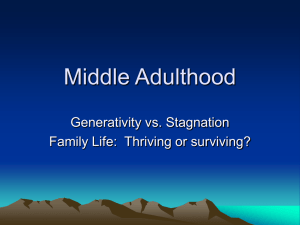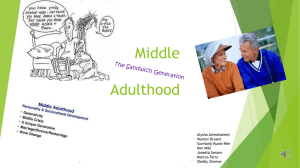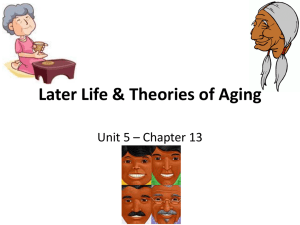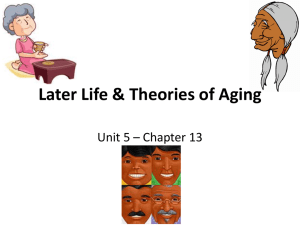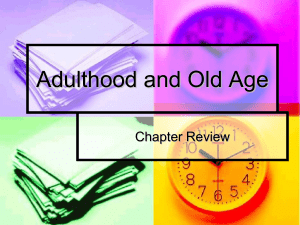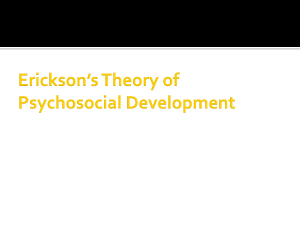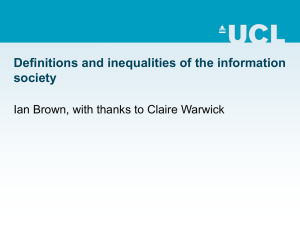workshop format - Center for Positive Organizations
advertisement
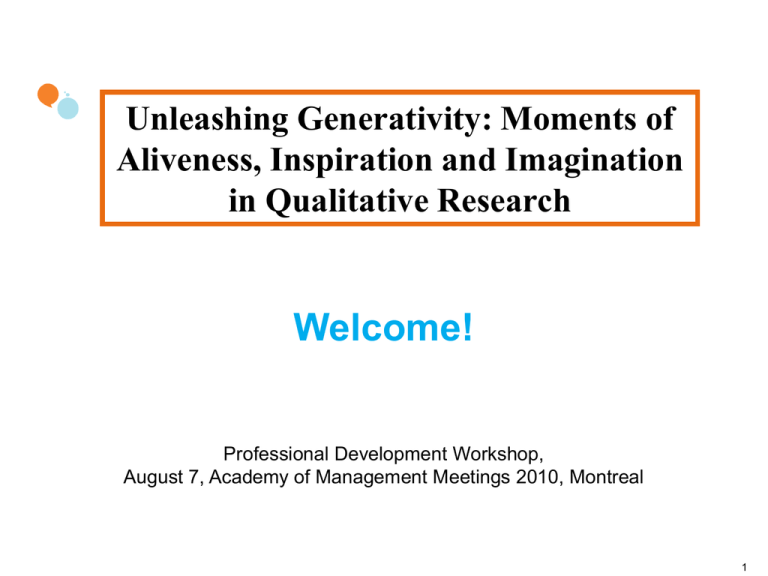
Unleashing Generativity: Moments of Aliveness, Inspiration and Imagination in Qualitative Research Welcome! Professional Development Workshop, August 7, Academy of Management Meetings 2010, Montreal 1 Workshop Goals 1. Facilitate learning about the concept of generativity and its utility 2. Engage you in learning from the sharing of generative moment narratives: a. b. c. d. Make sense of why it is important to care about generativity Create understanding of how to detect generativity Learn how to cultivate generativity in research Foster development of the community of qualitative researchers 3. Inspire experimentation through uncovering new research practices 4. Create meaningful connections with other qualitative researchers 2 Schedule Part 1: Introduction and setting foundation (25 minutes) Part 2: Playing with other people’s stories (30 minutes ) Part 3: Playing with your story (35 minutes) Part 4: Cultivating conditions for generativity (20 minutes) Part 5: Closing - Invitations to coming alive in doing qualitative research (10 minutes) 3 Introductions Participants: Say your name and one sentence about what most excites or exhausts you about qualitative research … © Anderson, Carlsen, Dutton Organizers: Jane Dutton, University of Michigan Arne Carlsen, SINTEF/Norwegian University of Science and Technology Facilitators: Kjersti Bjørkeng, SINTEF/Norwegian University of Science and Technology Marlys Christianson, University of Toronto Stewart Clegg, University of Technology, Sydney Karen Golden-Biddle, Boston University Libby Hemphill, University of Michigan Sally Maitlis, University of British Columbia 4 Foundations: What is Generativity? Generativity = Strips of experience that bring a feeling of energy and aliveness to people and also have the potential to produce more enduring expansive and transformative consequences with regards to 1) development of ideas, 2) development of researchers, their practices and relationships, and 3) thought-action repertoires of people in the researched organizations. 5 Foundations: Roots of Generativity? © Anderson, Carlsen, Dutton Narrative & literary theory: the generative properties of richness (e.g. Bruner 1986; Clandinin and Connelly 2000) and the life of ideas (Gergen 1978, Barthes 1981; Bakhtin 1981). Positive organizational scholarship: life in research (Dutton 2003), human growth in practice (Roberts et al 2005; Carlsen 2006) and mechanisms that are psychologically strengthening for individuals and collectives (Dutton and Glynn 2008) Appreciative inquiry: unlocking generativity in organizational development and in theorizing (e.g. Cooperrider and Srivastava 1985; Bushe 2009) or IT systems (Avital and Déenie 2009) Theory about discovery and imagination in interpretation (e.g. Kearney 1998; Weick 1989; Anderson 2004; Locke, Golden-Biddle and Feldman 2008). Motivational drivers of generativity in identity theory (Erikson 1950) and narrative psychology (McAdams et al 1997; Bauer and McAdams 2004; McAdams 2006). 6 Why Generativity? 1 Descriptive: Provide a fuller account of the research experience to include somatic, participative and affective modes of knowing 2 Enabling: Build developmental resources for qualitative researchers 3 Invitational: Imaginine instances and conditions for life in research and starting a conversation 7 Why moments? Why stories? “Epiphanies of the ordinary” © Anderson, Carlsen, Dutton Moments are units of experiencing that Broaden how we learn from research practice: do not presuppose grand journeys (as in Frost and Stablein 1993; Stablein and Frost 2004), Attend to the seemingly mundane (Morrill 2011). Attune us to opportunities for generativity that are enmeshed in the ‘halo and penumbra’ (James 1890/1950: vol. 2: 255) of streams of experience Stories are well-suited for examining generativity because they capture the Processual: connecting sequences of human doings and intentions over time (Sarbin 1986) Holistic: preserving richness and connectedness in experiencing Historically-situated: attending to the intersection of the temporal patterns of inquiry and that of researchers. 8 Playing with other people’s stories © Anderson, Carlsen, Dutton Break into groups of 3-4 (appoint a person who will report out from your group, a note taker) Read Story 1 in your notebook (make sure you are reading the same story—there are different stories at different tables—note PDW facilitators, these are your stories from the book! ). Each quad or trio discuss: 1. What’s the plot in the story? 2. Where is the generativity in the story? 3. What are the impacts of the generativity? 4. What are the practical implications for doing qualitative research? Insight Sharing (whole workshop group) 9 Playing with your own stories © Anderson, Carlsen, Dutton Break into dyads — try new pairing! Jot down notes about a generative moment you have had in doing qual research—put on blank card: Focus on a particular moment. Paint the scene about where you are and what happened? Share with a partner. Discuss together: Where was the generativity in your story and what did it do (to you, to others, to the research process )? What facilitated each other’s generative moment? What is one action you could take to make more probable a generative moment or positive impacts of generative moments? Insight Sharing (whole workshop group) Be prepared to share one insight from your dyad. 10 Cultivating generativity in research practice Move to using insights about generativity in research to infuse and inspire practice. Back in your trios and quads—take out the deck of cards Look at the images and implication summaries from our 8 focal stories Consider what has been shared in the room. What excites your quad the most ? What can you use tomorrow? Share with each other—Shout out of take-aways (whole group) 11 Coming alive in qualitative research Lessons across 40 stories from new and established scholars: ①Come alive through exploring tensions and liminal space ②Come alive through facilitating play ③Come alive by seeking participatory modes of engagement ④Come alive through co-discovery, also with practitioners ⑤Come alive through questioning and comparing ⑥Come alive in embracing a sense of wonder ⑦Come alive by engaging in sparkling conversations ⑧Come alive by cultivating habits of humility 12 Follow-up? What’s next? A book: Carlsen A. and Dutton J. E. (Eds). 2011. Research Alive. Exploring Generative Moments of Doing Qualitative Research. Copenhagen: Copenhagen Business School Press. A website for resources on generativity in qualitative research: Submit your own story, read stories of others, flash cards, papers, workshop materials Continue the conversation!: Engage fellow travelers whether students, researcher colleagues or practitioners: Share stories and ask the questions! 13 References Anderson, D. R. (2005). The esthetic attitude of abduction. Semiotica 153(1): 9–22. Avital, M. and Te'eni, D. (2009). From generative fit to generative capacity: Exploring an emerging dimension of information systems design and task performance. Information Systems Journal 19(4): 345-367. Bakhtin, M. (1981). The Dialogic Imagination. M. Holquist, (ed). Austin: University of Texas Press. Barthes, R. (1981). Theory of the text. R. Young, ed. Untying the Text: A Post-Structuralist Reader. Routledge, London, 31-47. Bauer, J. J., & McAdams, D. P. (2004). Personal growth in adults- stories of voluntary life transitions. Journal of Personality, 72, 573-602. Bruner, J. (1986). Actual Minds, Possible Worlds. Cambridge, MA: Harvard University Press Bushe, G. (2009). Generativity and the transformational potential of appreciative inquiry. In Zandee, D., Cooperrider, D.L. & Avital, M. (eds.) Organizational Generativity: Advances in Appreciative Inquiry Vol 3. Amsterdam: Elsevier. Cameron, K., J.E. Dutton and R.E. Quinn (2003) Positive Organizational Scholarship. San Francisco: Berrett-Koehler Publishers. Carlsen, A. (2006). Organizational becoming as dialogic imagination of practice. The case of the Indomitable Gauls. Organization Science, 17, 132-149. Clandinin, D. J. and F. M. Connelly. (2000). Narrative Inquiry: Experience and Story in Qualitative Research. San Francisco: Jossey-Bass. Cooperrider, D.L. & Srivastava, S. (1987). Appreciative inquiry in organizational life. In R. Woodman & W. Pasmore (eds.), Research in Organizational Change and Development, vol. 2: 129-169. Greenwich, CT: JAI Press. Dewey, J. (1925/1958). Experience and Nature. 2nd edition. New York: Dover. Dutton. J. E. (2003). Breathing life into organizational studies. Journal of Management Inquiry, 12, 5-19. Dutton, J. E. and Glynn, M. (2008) Positive organizational scholarship. In Handbook of Organizational Behavior, C. Cooper and J. Barling (eds.), London: Sage Publications, 693-712. Erikson, E.H. (1950) Childhood and Society. New York: W.W. Norton and Company. Frost, P. and Stablein, R. (Eds.) (1992). Doing Exemplary Research. Newbury Park, CA: Sage. Gergen, K. (1978). Toward generative theory. Journal of Personality and Social Psychology, 36,1344-1360. Heshusius, L. and Ballard, K. (Eds.) (1996). From Positivism to Interpretivism and Beyond. Tales of Transformation in Educational and Sociological Research. New York: Teachers College Press. James, W. (1890/1950). Principles of Psychology. New York: Dover. Kearney, R. (1998). Poetics of Imagining. New York: Fordham University Press. Locke, K., Golden-Biddle, K. & Feldman, M. (2008.) Making doubt generative: Rethinking the role of doubt in the research process. Organization Science 19(6): 907 – 918. McAdams, D. P. (2006). The redemptive self: Stories Americans live by. New York: Oxford University Press. McAdams, D. P., Diamond, A., de St. Aubin, E., & Mansfield., E. (1997). Stories of commitment: The psychosocial construction of generative lives. Journal of Personality and Social Psychology, 72, 678-694. Roberts, L. M., Dutton, J. E., Spreitzer, G., Heaphy, E., & Quinn, R.,E. (2005). Composing the reflected best self portrait. Building pathways for becoming extraordinary in organizations. Academy of Management Review, 30, 712-736. Sarbin, T. R. (ed). (1986). Narrative Psychology. Praeger Publishers, Westport Stablein, R. E. and Frost, P. J. 2004. Renewing Research Practice. Stanford, CA: Stanford University Press. Weick, K. E. (1989). Theory construction as disciplined imagination. Academy of Management Review 14(4): 516–531. 14
